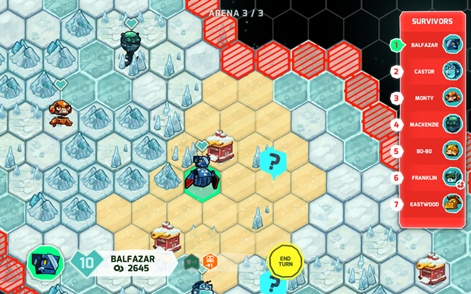Analytics has long been a key tool in maximising the potential for success in a game.
Learning the key metrics and exactly who's playing your game and when can help you target the right players, study their playstyles and learn where players may be dropping off from your game.
Given the importance of analytics to both how a game developers and its long-term success by tracking user behaviour, we ask:
- How are you using analytics to make better games and what have you found to be the most effective actionable insights?

With over 15 years’ data mining experience, Mark co-founded deltaDNA, formerly GamesAnalytics, to unlock big data to drive player understanding, introducing the concept of Player Relationship Management to build better games.
Making a great game that monetises well shouldn’t be a lottery. Companies that repeatedly top the charts, invest in analytics and place data-led insights at the heart of the development process. The most effective actionable insights involve knowing your game, knowing your players and optimising your monetisation.
In order to assess the health of your game, we recommend, as a great place to start, analysis of repeat spending patterns, as players progress through the game, and understanding the relationship between churn, spending and pinch-points. This helps to assess on-boarding, game difficulty, and identifies opportunities for better messaging.
Datamining lets you define clusters of behavioural interactions within your game, and these in-turn reveal the player archetypes and engagement triggers that underpin real-time, personalised player messaging, and adjustment to the balancing of game parameters for player segments.
Monetisation is best optimised by balancing ads with IAP and to do that, ads should be treated as a game mechanic and assessed in the same way. Specifically this should include A/B testing of placement and set-up within the game.
The outcome should be a segmented approach that ensures IAP opportunities aren’t cannibalised by ads, and rewarded ads are only shown to those who engage with them, so the right monetisation mechanism is used for the each player, whether it’s an offer, rewarded ad or an interstitial.
Freemium games frequently need fresh content to keep users engaged and require a multitude of game operations in order to increase retention and monetisation. As you need to keep your players happy you need to make game iterations and improvements; even if your game was published years ago.
The most effective insights are the knowledge of your lifecycle and segmentation based on your game economy.Alfonso Villar Chicharro
This game iterations are backed up with player's feedback and analytics. If you make iterations based on these two concepts you will see how your KPIs improve over time.
The best way to proceed is first look at your KPIs and check which one you want to improve. Then implement new game mechanics or game settings in order to improve the metric in an A/B testing model.
Once you have enough data, analyse it to check if that change improved the objective. If so, deploy it to all the players and if not, try it again changing the parameters. That's the way to operate a freemium game from the analytics perspective.
The most effective insights are the knowledge of your lifecycle and segmentation based on your game economy. If you truly understand how your players are segmented and how they are engaged with your game you will be able to improve and implement your strategy.
For example, show ads to users that will never spend, cross-promote players that are about to churn or increase ARPPU of your super fans with special offers at the right time.
We are using analytics in just about all parts of our games to find out what is working well and what is working badly in the game. The most effective actionable insights in my experience really depend on the state and situation of the game and the way the available data is used.
The project I am currently working on is in soft launch and we have been focusing heavily on getting progression and balancing right lately. Analytics helped a lot to learn where actual player behavior and progression matched our assumptions and designs and where it did not. Thus we were able to improve these areas significantly.
Another focal point has been onboarding. Funnel analyses have been really valuable in order to find pain points in onboarding to smooth out the first time user experience.
These are just two of many examples. So, if set up and used correctly, analytics can really give great insights about where a game could be improved.
We lead with creative and validate with metrics (trust but verify). Retention is valued above any other metric (yes, it’s more important than revenue).
With each update, we track player funnels to see whether we have the difficulty balancing right and whether there’s room to still improve. We track player behavior and completion rates on the latest levels to check that all the new features and additions behave as expected.
The typical easiest actionable item is the difficulty. Spike too hard and players get stuck and will give up. Go too easy and players will zone out and the game loses some of it’s charm.
With Best Fiends, we also periodically review a lot of the game content. Which characters the audience loves? Which characters they don’t use? And then we go back and improve on the latter characters.
The great thing about analytics is that you’re genuinely creating the game with the audience. In the past, you’d just make a game, put it into a box and ship it out. Now we can see what worked and what didn’t and can always improve.
As a small indie developer, we don't have the resources to dedicate a full-time analyst so any data that we glean from analytics needs to be immediate and useful.
We quickly learned that it's super-important to decide up front what data was needed and focus on that. Otherwise it's all too easy to drown in a sea of information because of the sheer volume and complexity, and we just don't have time for that.
Our 'Quell' puzzle games tend to have an older core demographic, who expect a fair and gentle difficulty curve. Analytics has enabled us to see which levels players were having difficulty with, and either re-order or re-work the levels in question.
We always try to balance the puzzle components of our games with a compelling narrative. The story can encourage the player to persevere past those inevitable "I'm stuck" moments - because they want to see what happens next.
But some players don't care for a story. Analytics helps us to see who is reading the fiction (and for how long), and who is hitting 'skip'. This gives us incontrovertible evidence to 'tone it down' in some places.
Especially at early stages, aligning our product decisions with market trends is very important to us. Once in development we systematically make use of user tests and app data.
During the very first stages of prototyping we combine those with extended in-house test events to drive our game design decisions. Particularly the tracking of player behavior in the first time user experience and retention metrics are decisive for us to improve the introductory funnel as much as possible before we launch.
Knowing the players is essential for us to deliver an optimised experience. We have a team of dedicated product and data scientists supporting with all kinds of insights to create a deep understanding for what drives our players.
This also requires our databases to be very performant and agile.
At Next Games we look at analytics from two points of view: micro and macro analytics. The former mostly has to do with data aggregated on the basis of cohorts, acquisition channels, geographical regions and such. Actionability, however, comes from micro analytics which is concerned with what players do in the game, even down to how players interact with an individual UI action.
When working with a massive IP like The Walking Dead, combining macro and micro analytics is key. We have an amazing fan base and meeting their expectations begins before they even immerse themselves in the game. Looking at in-game behavior alone would only give us half of the picture.
We strive to create the best possible flow for our players, from marketing the right asset, to introducing content in the best way, and providing products that match expectations.
We believe the best results are achieved when analysing the entire funnel and understanding the full experience for the players.
This starts with predicting what the post-episode buzz will be about so that we can engage fans and players in a relatable way, and allows us to respond to player expectations of our game as an extension of The Walking Dead series.
Our latest update with a deep season 7 content integration is a testament of that. In short, for us, actionable insight goes way beyond analysing one particular behavior at a time.
For Playniac’s Insane Robots, coming to PC, PlayStation 4 and Xbox One in early 2017, we are using analytics to answer key game design questions.
Analytics are always useful to give insight into player behavior and to observe, for example, which levels, features or content are the most popular. But they are also a useful tool for game balancing.
For example, with a turn based card battle like Insane Robots it is important to avoid first-move advantage. This is where, on average, the starting player is more likely to win any individual battle.

Initially we used a computer model to run 1000s of AI vs AI battles and demonstrate that the outcomes are not biased. For beta tests and continuing after release, we will be using analytics to gather much larger real-world sample sets. If the analytics show that it is necessary, we can tweak the game to rebalance it.
Analytics can also be used to help recognise and remove dominant strategies. This is where players find a single strategy that is always the best one to follow.
For example, in Insane Robots there are 100 augments that players can use to customise and modify the capabilities of their robots. We have already tested these in play tests, but you cannot try every possible combination.
Once again, we will use analytics to gather large, real-world sample sets and analyse whether specific augments or augment combinations are being used to dominate the game. If patterns do emerge, we will be able to redesign those features.
Overall, with analytics and careful analysis of the findings, we can make Insane Robots even more fair and even more fun for our players.



























